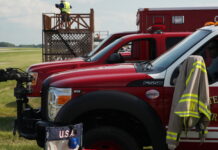Coordination of Crash Fire Rescue (CFR) assets is an often overlooked detail at many shows. Regardless of the size of the crowd, the number and type of acts, or the type of CFR assets at your disposal, a thorough understanding of CFR response and control is an absolute requirement of the “responsible party,” the air boss and the ramp boss.
During the final pre-show coordination meeting, the air boss, CFR chief, tower boss (if there is a tower), narrator and the “responsible party” should discuss, in detail, who is going to do what, where, when, how and with what controls, arriving at an agreement that is clear and addresses every conceivable type of problem.
Items to consider:
Standard Operating Procedure (SOP) – Every effort should be made to fold the non-standard operations of an air show into the SOP of the airport as quickly as possible. Airport personnel are intimately familiar with their day-to-day SOP and building the air show CFR response around it is a good idea for many different reasons.
Rescue – Every crash truck fire fighter must attend the aircraft ramp walk-through to be educated on the proper ingress/rescue/egress procedures and the proper switch/valve positioning for each type of aircraft. This should be considered a high priority.
Overturns – Every event should have a 10-ton forklift or boom crane on site under the direction of the CFR chief. If an aircraft is overturned and cannot be up righted, grab the aircraft by the propeller and lift it to free the pilot.
Communication – If a tower is on the field, all CFR communications should go through the tower on the normal tower/CFR net. This is what they practice. If there is no tower, the air boss and the chief on duty must have an exact understanding of how they will communicate.
Positioning assets – Where will the assets be stationed? Do they have unrestricted and unimpeded access to the areas with the highest probability of problems? (Do not forget the vendor area.)
Transportation — The vehicle traffic plan should include CFR vehicles, a special (non-public) exit route, and coordination protocols for opening that route if/when they are needed. Helicopter emergency usage should be included in the plan.
Staffing – Does the fire support team have enough manpower? What about lunch? The show will continue; will it still have CFR coverage? Without CFR coverage as required in the waiver, the waiver is invalid and the show must stop.
Family – At many shows, the immediate families of the fire fighters are allowed to come to the show and sit with them. That is a fine gesture; however, when the fire fighter is on duty, the family should not be in the response area. Time delay of a few seconds – to get the kids off the truck or to move the chairs from in front of the truck – could be the difference in a life.
Physiology – Fire fighters work under hot, stressful, confused conditions; thus, it is imperative that the event organizer take great pains to ensure the physiology – shade, water, food, toilet – aspects of the CFR force is well taken care of.
The CFR duty chief, or his representative, must be at the daily safety and sequence briefing. This is the ideal time to update any schedule/response issues as well as coordinate rescue training for shift working firemen and any new aircraft arrivals.








